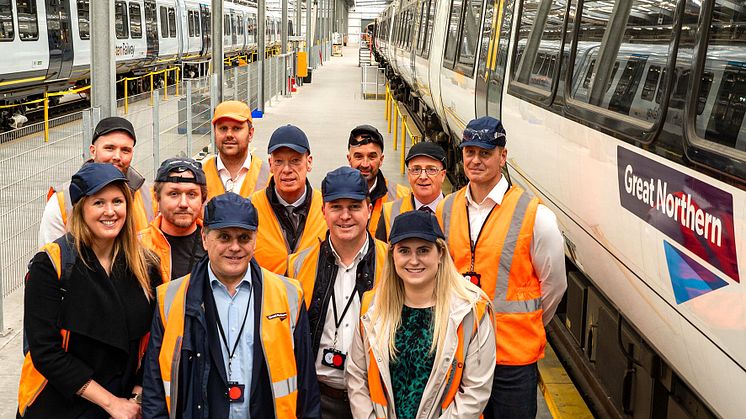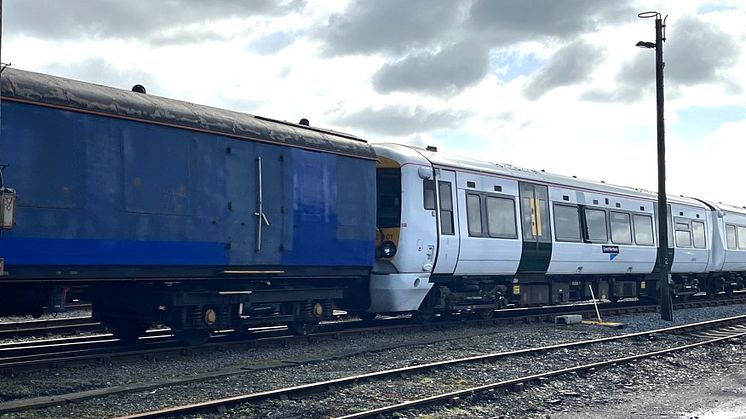
Press release -
GTR’s first Class 387/1 completes static testing of new digital ETCS in-cab signalling equipment
Govia Thameslink Railway’s (GTR’s) first Class 387/1 Great Northern Electrostar train has now completed static testing of its retrofitted European Train Control Signalling (ETCS) in-cab signalling equipment, as part of the East Coast Digital Programme, aimed at improving performance for passengers, while reducing emissions.
The Class 387 is the country’s first major commuter fleet to have the technology retrofitted, and it lays the foundations for the digital upgrade to be applied to the rest of the UK’s vast Electrostar fleet, for future expansion of ETCS across other routes.
Unit 387101’s recently retrofitted onboard ETCS system (Atlas 3) was commissioned at Alstom’s Litchurch Lane manufacturing site in Derby where each new piece of equipment went through powered-up electrical testing. Alstom also carried out low-speed dynamic testing of the Eurobalise antenna and odometry system, which detect the train’s location.
On 23 May, the train was hauled by GBRf from Litchurch Lane to the Rail Innovation and Development Centre (RIDC) in Melton Mowbray (see picture below), where dynamic testing of the ETCS odometry equipment will commence, expected to take approximately three weeks.
This is the first of three dynamic testing events for Unit 387101 at RIDIC; all three tests are expected to have been completed by October 2023.
This ‘first-in-class’ train is set to return in November 2023, after which GTR will fit the remaining 28 387/1 units at its in-house depot in Hornsey, north London.
GTR’s ERTMS Fleet Project Manager Aaron Meakin said: “We’re delighted with how the newly retrofitted ETCS system has performed on our Class 387 train in static testing. It bodes well as we move into dynamic testing at RIDC. Our engineering team and the team at Alstom are working closely together to ensure success and we’re looking forward to continuing this collaboration.”
Aaron Weeks, Project Director for Alstom said: “The Class 387 is the first unit in the UK to utilise the newest generation of Alstom’s ETCS Onboard signalling product, known as ATLAS 3. We are delighted to successfully complete the fitment and static testing and now we are looking forward to dynamically testing the train at RIDC in the coming months.
“Alstom recognises that the digitisation of the UK rail network needs new ways of innovative cross industry working and the ongoing close collaboration between our team and partners at GTR, Porterbrook and Network Rail on this project is a great example of this.”
The Government-funded East Coast Digital Programme will see traditional signals removed from the tracks on the Northern City Line to London Moorgate and the East Coast Mainline from London to Stoke Tunnels, south of Grantham. They will be replaced with state-of-the-art digital signalling technology. This will improve reliability, meaning a better performing rail service for customers using this key route.
In-cab signalling provided by ETCS Level 2 operation supplies continual speed information and movement authority to the driver via a computer screen in the driver’s cab, rather than relying on fixed lineside signals.
Ed Akers, Network Rail’s Principal Programme Sponsor, East Coast Digital Programme, said: “This is another important step forward in the largest passenger fleet retrofitting project in the ECDP. We’ve got here because of pioneering collaboration across multiple industry partners. The partnership working will continue as the train gets put through its paces at our upgraded facilities at RIDC, preparing the way for its use with digitally signalled passenger services.”
Ben Ackroyd, Chief Operating Officer at Porterbrook, which owns GTR’s Class 387 fleet said: “Successful completion of static testing signals an important milestone in this project aimed at improving performance and reliability for passengers. We’re proud to be playing our part in this industry partnership and look forward to continued collaboration as the ‘first-in-class’ train moves into dynamic testing.”
Ends
Editors’ notes
The recently installed ETCS equipment that underwent static testing included:
- A new digital driver's dashboard
- A new AWS/TPWS system
- Doppler radar and ETCS antennae beneath the soleplate
- A European Vital Computer – the main computer – fitted at the body end of the first carriage
- Onboard ETCS software – in line with the latest revision of the ETCS standards
In addition to the Class 387s, GTR operates two further fleets of train which will eventually be run under ETCS as part of the East Coast Digital Programme:
Class 717s
- GTR’s 25 Great Northern Class 717 trains were built fitted with ETCS. They operate the Northern City Line, which runs from the East Coast Mainline at Finsbury Park to London Moorgate, where Network Rail has installed digital infrastructure as part of the East Coast Digital Programme
- The trains have been dynamically tested on the route and GTR has been given authorisation from the Office of Road and Rail (ORR) to use them in passenger service. Driver training will begin in passenger service once the infrastructure receives similar sign-off
- The Class 717s came fitted with B3MR1 (also referred to as version 3.4.0), but GTR will be upgrading the software to 3.6.0 and, this autumn, will be testing the latest version of ETCS ahead of upgrading the software on the entire fleet early next year, so that the trains are ready to operate in ETCS on the East Coast Main Line.
Class 700s
- All 115 of the Thameslink Class 700 trains which are already fitted with ETCS will be upgraded to the latest version of BL3 R2 (also referred to as version 3.6.0).
Topics
Categories
For more information, contact the press office on 0203 750 2031.
Govia Thameslink Railway
Govia Thameslink Railway (GTR) operates Thameslink, Great Northern, Southern and Gatwick Express services as follows:
- Thameslink – cross-London services between Bedford/Peterborough/Cambridge and Brighton/Horsham/East Grinstead, and between Luton/St Albans and Sutton/Wimbledon/Rainham; plus services between London and Sevenoaks
- Great Northern – services between London and Welwyn, Hertford, Peterborough, Cambridge and King’s Lynn
- Southern – services between London and the Sussex coast (Brighton, Worthing, Eastbourne, Bognor Regis, Hastings) and parts of Surrey, Kent and Hampshire (Ashford International, Southampton, Portsmouth)
- Gatwick Express – fast, non-stop direct services between Gatwick Airport and London Victoria
www.southernrailway.com, www.thameslinkrailway.com, www.gatwickexpress.com, www.greatnorthernrail.com


